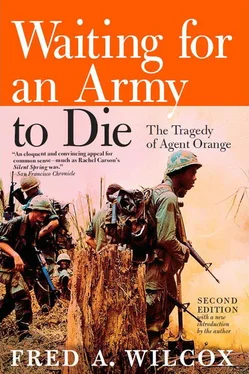The Oregon Regional Primate Research Center, McNulty explains, is one of the seven primate centers established in the early sixties as scientific institutes under the assumption “that because primates are our nearest biological relatives they might in many cases be good or even superior models of handling diseases.” Because the supply of rhesus monkeys appeared to be inexhaustible, they were considered ideal for laboratory experiments, but in recent years an international controversy has developed over the capture and sale of this species of primate. After several decades the rhesus population has been so depleted that at least one Asian nation has placed a ban on their export.
“But we don’t have to worry too much about all that,” McNulty explains with a touch of pride. “In fact, we now have over 2,500 primates living on the grounds of our center. And they live outdoors all the time all year round, and they seem to do quite well in this climate. We’re pretty self-sufficient, at least where the rhesus is concerned, and no longer depend on capture from the wild.”
When he first began feeding a select group of rhesus monkeys minute quantities of TCDD-dioxin, McNulty was actually doing research into polychlorinated biphenyls (PCBs), which he describes as his first love. “Back some years ago, the thought was around that the toxicity of PCBs might not in fact be due to the PCBs themselves, but rather to a contaminant that was contained in the PCBs, something called polychlorinated dibenzofurans. But there really wasn’t any information available at that time on the relative potency of PCBs and/or the dibenzofurans. So, obviously, in order to investigate whether the toxicity of commercial PCBs might be due to contaminants, I had to know just what the potency of the contaminant might be. But the contaminants were not available; however, since the polychlorinated dibenzofurans are a very close relative of dioxin, which was indeed available, I started testing with a dioxin compound called TCDD. I wanted to see just what its relative potency might be, and as you can well guess, it was enormously more potent than PCBs, although qualitatively the diseases they cause are the same. On a per-weight basis dioxin is much, much stronger.”
In the beginning McNulty placed what he thought were small quantities of dioxin in the food of his rhesus monkeys. “As fools rush in,” he admits, “the doses, in retrospect, were astronomical. They were in the parts per billion instead of parts per trillion range, which is more relevant when it comes to food. I think the first level I used was twenty parts per billion in the diet, and that killed a young male rhesus monkey in twelve days. This was an estimated total intake of well under ten micrograms (TCDD) per kilogram (body weight). A level of two parts per billion was lethal in seventy-six days. I discovered that monkeys are several times more sensitive to TCDD than mice, rats, rabbits, and dogs.”
Dioxin turned out to be so toxic to his experimental animals that McNulty decided to suspend all research with TCDD until the primate center could construct a special building with carefully controlled access, assigning the care of his monkeys to only one or two well-trained people in an effort to minimize the risk of contaminating other areas of the center.
“Dioxin,” says McNulty, “is the most toxic small man-made molecule we know of. It is less toxic on a per-gram basis than some biological toxins like botulin, but that’s a very huge molecule. So molecule for molecule dioxin is probably the leader of the pack.” [16] According to Harvard researcher Matthew Meselson, dioxin is also much more poisonous than the most toxic military nerve gases, which also consist of small molecules.
After consuming food containing minute amounts of TCDD, McNulty’s primates became very quiet, began losing weight, lost their appetite, grew progressively thinner and weaker, and then “just laid down and died.” Sometimes they would have episodes of retching and vomiting, but, says McNulty, “these were at the higher doses. At much, much lower doses a certain fraction of the animals remain well for one to three or four months, and then will suffer from an ailment characterized by failure of the elements of the bone marrow. They will have low white counts, very low platelet counts, so that they suffer from hemorrhages and infections and are essentially carried away by bone marrow failure.” [17] “What appears to be happening,” says Matthew Meselson, “is that cell division stops. Spermatogenesis stops, the replacement of red blood cells stops, the regeneration of the epithelial lining of the gut stops. After a few days or weeks without cell division the animals simply fall apart.”
1
Unlike Vietnam veterans who complained of fluctuations in weight patterns, gains as well as losses, the monkeys did not regain weight they lost. “They just go down,” says McNulty, “although I did have one animal who lost a lot of weight over a period of about three and a half months, without showing any of the other characteristic signs of toxic poisoning. And then she began to regain her weight and is still alive today, and appears to be quite well. But usually if they are sufficiently poisoned that they lose a significant amount of weight, they don’t recover from it. It simply goes on and they become worse and then they die.”
Although TCDD, when given to rats and mice in minute doses, causes congenital abnormalities, including fetal deaths, cleft palate, and kidney abnormalities, McNulty’s research failed to indicate that TCDD acts as a teratogen in rhesus monkeys. McNulty did find, however, that TCDD is fetotoxic in rhesus monkeys. “The experiment,” says McNulty, “was designed to explore whether short-term exposure to dioxin, either in a single or a few closely spaced doses during that period in early pregnancy when the organs are forming, would result in malformations. At the highest dose it was very toxic to the mother, and since I wasn’t really interested in that, I did very little at that particular level. At the intermediate level there was a fairly high level of abortion, or loss of the fetus. But those which did not abort gave birth to normal offspring. We were unable to find any malformations. Also, at the level that TCDD caused a fair number of abortions there were some late toxicities and deaths among the mothers. But the number of animals was relatively small, and unlike experimenting with rats and mice, you can’t use the number you would like for statistical significance. Still, with the relatively small number of animals I used it seems extraordinarily likely that TCDD is toxic to the fetus, but I did not conclude that it causes malformations in the offspring of rhesus monkeys.”
Fetotoxic effects, which means the ability of TCDD to destroy developing fetuses, have been observed in three different mouse strains, two rat strains, and one species of monkey. In a study by Dow Chemical, rats fed on nanogram (billionth of a gram) of TCDD per kilogram body weight per day exhibited increased stillbirth and shortened life spans for surviving pups. Skeletal birth defects have also been observed in four different mouse strains as well as other types of defects in rats when pregnant females are exposed to TCDD. 2
Dr. McNulty has not researched the possible mutagenic effects of TCDD on male monkeys because, he says, “there isn’t any reason to think it would be a good experiment. As you recall, I said there is no evidence that TCDD is a mutagen, and any reproductive failures in terms of abortions or malformations that are going to be transmitted through the father almost necessarily have to be due to the mutagenicity of his germ cells. So it’s not the kind of experiment that’s likely to get results. Now, I’m sure Vietnam veterans would raise the question: ‘How do you know if you haven’t done it?’ Well, with mature monkeys now running around a thousand dollars each, it becomes a matter of choosing experiments that one has some reason to assume will give one conclusive results. It’s always difficult to prove that something doesn’t exist. In other words, how many males would I have to expose and then breed with females before I could say with confidence that TCDD does not cause reproductive failures through the male? One sure wouldn’t be enough. Would ten be enough? Not likely. Would a hundred be enough? Well, maybe, but still a little bit doubtful. And that’s just an impossibly expensive experiment if you don’t have any good reason ahead of time to think that it’s going to pay off.”
Читать дальше











